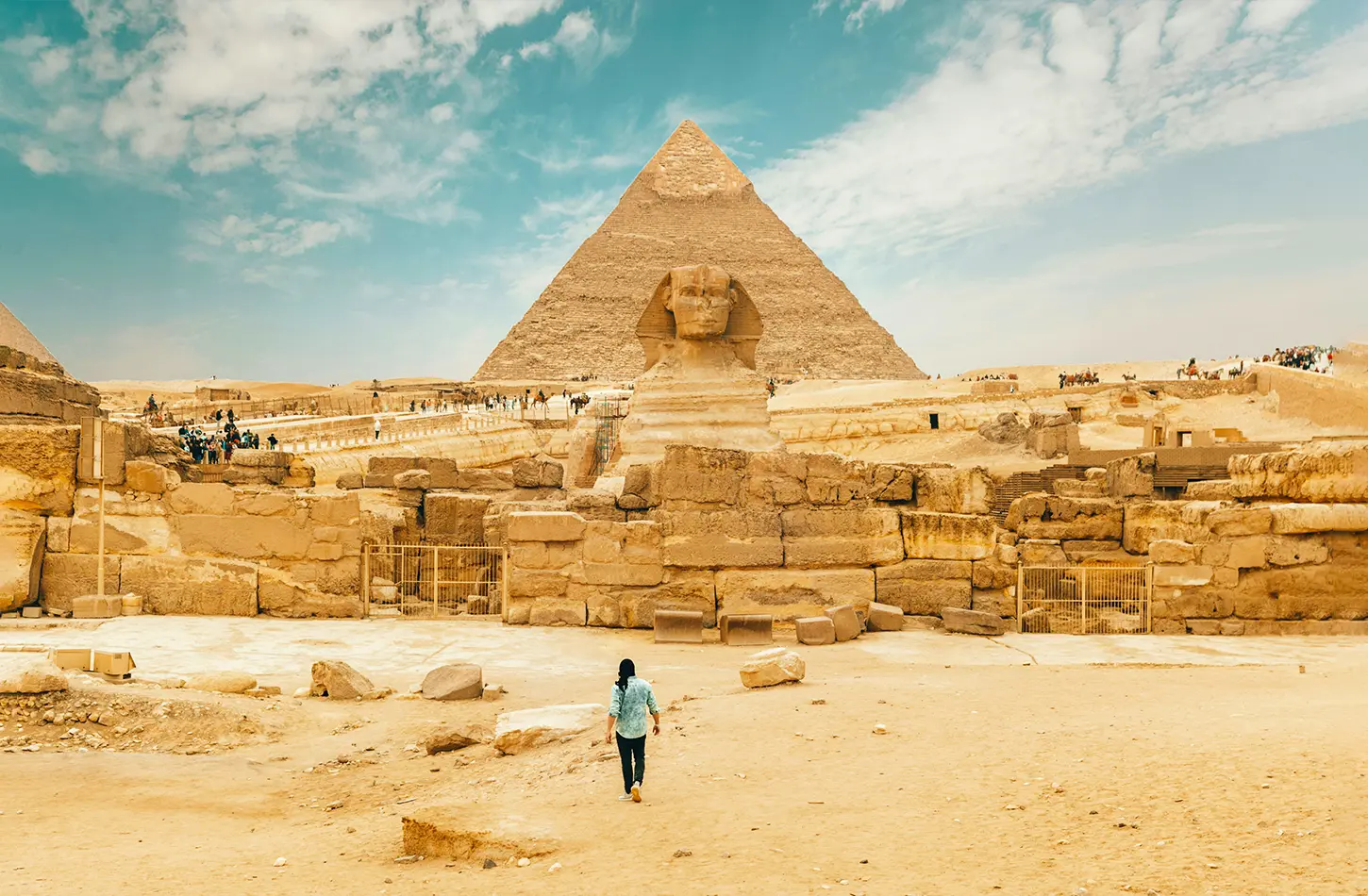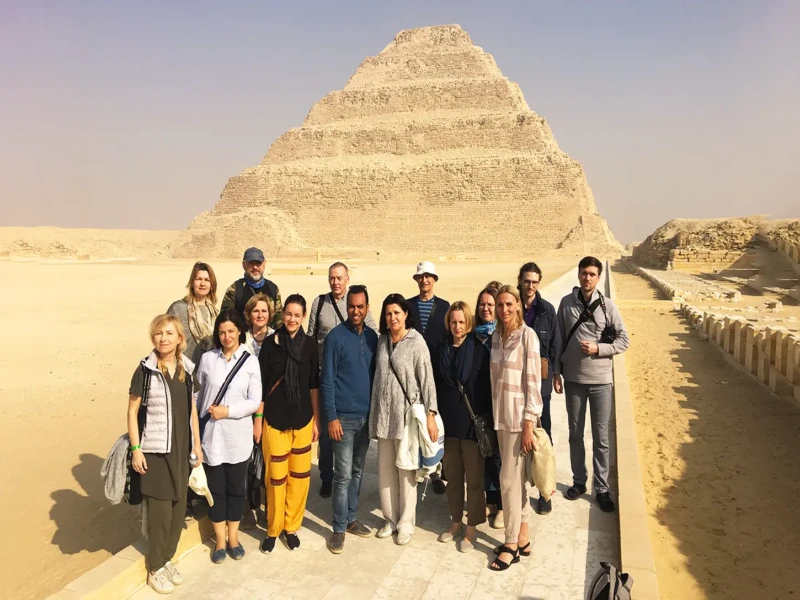Towering above the desert sands of the Giza Plateau, the pyramids of Egypt have stood as symbols of power, mystery, and unmatched human achievement for over 4,500 years. Built by the ancient Egyptians with no modern tools or machinery, these massive monuments continue to puzzle and inspire both scientists and travelers alike.
From the Step Pyramid of Djoser to the majestic Great Pyramid of Giza, each structure reveals a chapter of innovation in pyramid construction. These architectural wonders weren’t just tombs, they were feats of design, logistics, and spiritual devotion.
So how did a civilization manage to build the pyramids using only copper tools, manual labor, and ingenuity? And why do their secrets still captivate the world today? Let’s explore the fascinating story behind one of history’s greatest engineering achievements.
What Were the Pyramids Made Of? Huge Stones, Skilled Workers, and Ingenuity
The first thing to understand about how the pyramids were built is the sheer scale of the task. The Great Pyramid alone consists of more than 2.3 million stone blocks, some weighing as much as 15 tons. These huge stones were quarried, shaped, transported, and stacked with incredible precision, a task requiring not only physical labor but also careful planning and exceptional organization.
Most of the limestone blocks were quarried locally, just south of the Giza Plateau, while granite used in the burial chambers was transferred from Aswan, over 500 miles away. To move them, workers likely used wooden sledges on lubricated sand, a technique supported by wall paintings and recent archaeological findings.
And who were these workers? Far from being slaves, evidence now shows that the pyramids were built by skilled workers, paid laborers and artisans who took pride in their contribution to national and spiritual glory. Excavations have uncovered well-planned worker villages complete with bakeries, breweries, and medical facilities, proving these teams were well-fed and well-organized.
Want to dive deeper into these stories and sites? Our Nile Cruise & Giza Adventure includes exclusive guided access to ancient quarries and construction zones around Giza.
From the Step Pyramid to the Great Pyramid: The Evolution of Pyramid Design
The path to the iconic Pyramid of Giza wasn’t a straight line. Early attempts at pyramid building went through several experimental phases before achieving perfection.
The journey began with the Step Pyramid at Saqqara, built for Pharaoh Djoser around 2670 BCE. Designed by the architect Imhotep, it marked Egypt’s first large-scale stone construction, a stack of mastabas rising in a staircase-like shape.
Next came the Bent Pyramid at Dahshur, an ambitious attempt to create smooth sides. Halfway through construction, the angle of inclination was reduced, giving the pyramid its distinctive bent profile. The reason? Most likely to avoid collapse, a sign that engineers were learning and adjusting as they went.
Finally came the masterpiece: the Great Pyramid of Giza, constructed for Pharaoh Khufu. At an original height of 481 feet, it remained the tallest man-made structure on Earth for nearly 4,000 years. Its internal layout, including the burial chamber, the Grand Gallery, and precisely cut shafts, displays remarkable precision and cosmic alignment, likely tied to the stars and Egyptian beliefs about the afterlife.
If you want to experience the evolution of pyramid architecture from Saqqara to Giza, our Classic Egypt Tour Package is designed to take you on that exact journey through time.
So How Did They Really Build the Pyramids? Facts vs. Myths
The question “How were the pyramids built?” continues to fascinate millions. It’s a mystery that has inspired everything from scholarly debates to science documentaries, and even a few wild theories involving aliens. But the truth, based on decades of archaeological research, is far more impressive because it highlights the ingenuity of real people: the ancient Egyptians.
One of the most widely supported ideas is that massive stone blocks were hauled into place using a complex ramp system. These ramps may have been built straight and long, zigzagged up the sides of the structure, or even spiraled around the pyramid as it rose higher. Imagine the coordination and labor involved, hundreds of skilled workers, carefully guiding multi-ton stones upward one by one.
Another credible method involves wooden scaffolding, post holes, and lever systems to help maneuver the stones into precise positions. Some evidence suggests they used copper tools to shape blocks and well-organized crews to transport them from nearby quarries.
One particularly intriguing theory proposes that workers poured water onto desert sand ahead of sleds dragging heavy stones. This simple trick, shown in ancient wall paintings and backed by modern experiments, reduced friction and made it easier to move the massive loads. It’s another reminder of how cleverly ancient Egyptians used natural elements to solve engineering challenges.
Today, ongoing excavations at the Giza Plateau continue to unearth incredible insights, from workers’ camps and copper chisels to ancient graffiti and remnants of temporary infrastructure. These discoveries bring us closer to understanding how such precise, enormous structures were constructed over 4,500 years ago without cranes, steel, or digital tools.
What makes the story even more powerful is knowing it wasn’t magic or mystery, it was people. Skilled workers, organized teams, and bold thinkers who achieved what once seemed impossible.
Interested in seeing these ongoing mysteries for yourself? Join one of our expert-led Giza Plateau Exploration Tours to witness the ancient construction sites and tools still visible today.
From Fascination to Destination: Plan Your Trip
Reading about the pyramids is inspiring but nothing compares to standing before them in person. Whether it’s your first visit to Egypt or a long-awaited return, seeing the Great Pyramid of Giza up close is an unforgettable experience. Just a short drive from central Cairo, the Giza Plateau is accessible, making it easy to explore both the ancient structures and nearby attractions like Saqqara, Memphis, and Dahshur.
Many travelers choose guided tours not just for convenience, but to deepen their understanding of the rich history beneath each stone. Our travel packages pair pyramid exploration with visits to temples, museums, and cultural landmarks across Egypt, creating a seamless journey through past and present.
Curious what others thought? Countless travelers have walked away amazed, describing their trips as “life-changing,” “incredibly safe,” and “more impressive than they imagined.”
Ready to see it for yourself? Explore our Giza Pyramid day tours and stand where history was carved in stone.



